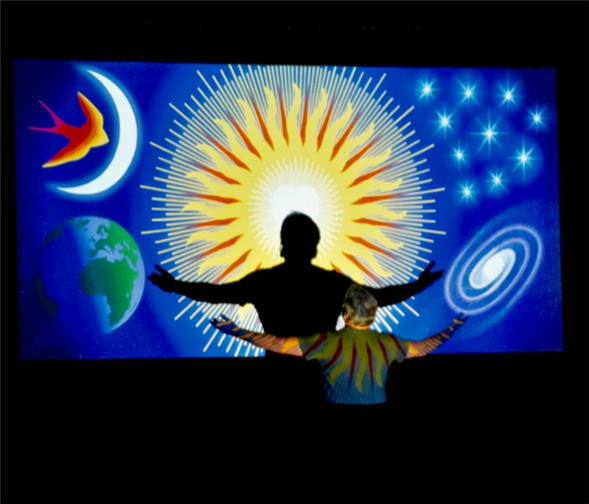Translate Page

Inside the 25-year journey of Patrick Dunning's The Signature Project
---
The Signature Project, currently running at the Sheen Center, was never meant to be onstage. The brainchild of Dublin-born, Oregon-based visual artist Patrick Dunning, it started back in 1990 as an ambitious 76 foot by 36 foot mural that would use the signatures of 1 million people to form a "universal" image, namely the sun, the earth, the moon, the stars, the galaxy, and a fiery phoenix. The undertaking was inspired by many disparate things: a "cosmic sensation" Dunning experienced while meditating as a teen, his father's death, his love of talking to strangers. But mainly it was a way for the artist to indulge his curiosity about, well, seemingly everything.
For The Signature Project contains much more than just autographs. As Dunning peels away the hidden layers that he's built up over the decades, he uncovers X-rays and Morse code and tiny figurines and even a theremin embedded into the canvas. We also hear about some of the people who've contributed to this ongoing endeavor, along with Dunning's own life story. That performance aspect is what makes The Signature Project a piece of theatre -- or not. Dunning and director/producer Eric Paul Vitale honestly aren't sure what it is.
A quarter century ago, Dunning started hawking The Signature Project at fairs and festivals across the U.S., explaining what he was doing to passersby and inviting them to sign in exchange for a small donation. "I was a carnival barker," he says in his charming Irish brogue. At one of these events, he met a staffer from the Oregon Museum of Science and Industry in Portland, who was impressed by Dunning's use of technology to determine how the colored signatures would come together to create the image. "I became the first artist in residence at the museum in 1997, and I was there about three years," Dunning recalls. "Someone said, 'You should get a slide projector and do a little presentation.' So I did. Later I got a digital projector and a screen. So the theatrical side of it really just grew organically. It wasn't something I planned at all. I started profiling people who signed it and those stories found a way back into the project. From this tiny seed of an idea, it blossomed in many different directions."
{Image1}
Dunning's museum tenure opened a lot of doors, and throughout the 2000s he traveled the country presenting The Signature Project for various organizations, primarily schools. "They saw the potential in the work because it fit nicely with the STEAM programs," he says, referring to the acronym for science, technology, engineering, art, and math, which is all the rage in curriculum planning. "And it's a lovely story, too. It's about life, the world, and the people in it. It's about my family and the global family. It's about connections."
About a year ago, Dunning was at an educational conference pitching The Signature Project when he met Vitale. "I found him captivating," Vitale recalls. "I went to a high school to see it and I told him, 'This is a really great play.' And Patrick said, 'What play? I don't think it's play.' And I said, 'Oh, it's definitely a play.'" Even though Dunning didn't consider The Signature Project a show, he was willing to give Off-Broadway a shot. "I had always wanted to be in a theatre to develop it a bit further," he says.
But first, he had to write it all down.
When Vitale asked for the script, "Patrick printed a PowerPoint slideshow on pieces of paper with notes that said, 'This is where I talk,'" the director says, chuckling. "I told him, 'I need to know the words that are coming out of your mouth." Vitale hired playwright Leegrid Stevens as a consultant and soon they hammered out the final text with room for Dunning to play -- after all, he's not an actor. Vitale also added numerous theatrical elements Dunning had never used before, such as lighting, sound, and projection design, plus dancers and instrumentalists (because yes, there's music in The Signature Project, too).
Because of its diverse ingredients, The Signature Project defies categorization. Even performance art doesn't seem to cover it. It's also a fascinating paradox as Dunning builds a piece of theatre by deconstructing his artwork and creative process.
"I mean it's a totally preposterous conceit to do something like this," Vitale says. "But I think that the best shows being made right now are the ones that are able to shake off the constraints of what we normally call theatre. I still don't know if The Signature Project is a piece of art or a play. I don't think it works without a performance, and I don't know if the play would work without a piece of art. But I do know that this experience gets to the heart of what theatre is supposed to be."
---
TDF MEMBERS: At press time, discount tickets were available for The Signature Project. Go here to browse our current offers.
Raven Snook is the Editor of TDF Stages. Follow her at @RavenSnook. Follow TDF at @TDFNYC.
Top image: Patrick Dunning in The Signature Project. Photos by Ingrid Butler.